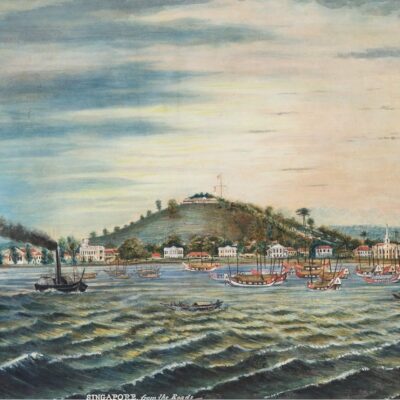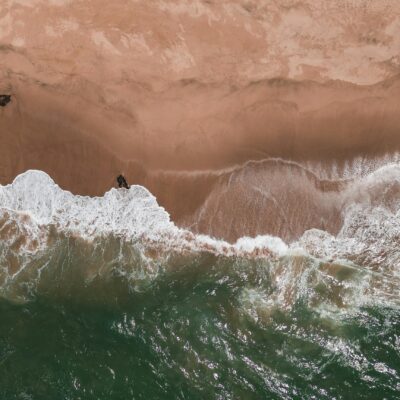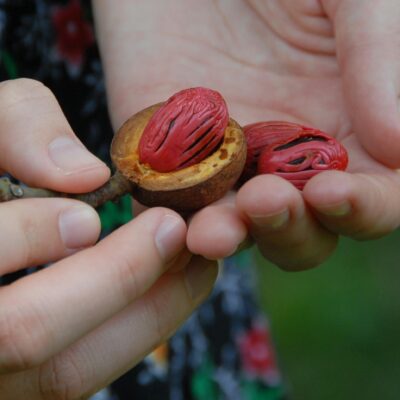A reappraisal of Southeast Asian landscapes at a regional and transhistorical scale reveals that artists see landscapes with what I call a ‘regional eye.’ A ‘regional eye’ is an approach to understanding and interpreting Southeast Asian landscape art which emphasises the relationship between land and water and which is a counterpoint to the Western-centric art-historical theory of a ‘period eye’, the idea that art is viewed and understood differently in different times and places.
Land and water
In artworks by the painter and poet Arthur Yap (1943–2006), chromatic eddies between warm and cool tones evoke a balanced commingling of land and water. These semi-abstract images feature a congruous interplay of watery bluish greens and dusty yellowish reds and browns. In Window View (1984), for instance, aquamarine and cerulean recall rainfall and puddles or pools, as well as larger bodies of freshwater or sea, while tawny shades of terracotta and lemon evoke vegetation, sand, and solid earth. Similarly, in Landscape and Landscape II (both 1980), meandering lines ambiguously suggest aerial views of coastline, and panoramic vistas of a tidal landscape, and perhaps even geological strata or meteorological data.

Image 1. Arthur Yap. Landscape. 1980. Mixed media on board, 50 x 40c m. Gift of Fanny, Jenny and Alice Yap. Collection of National Gallery Singapore. Image courtesy of National Heritage Board, Singapore.
These organic, flowing forms in the compositions underscore the harmonious range of colours, which together invoke a sense of the natural environment as balanced between the solid and the liquid, the vegetal and topographical, and the aquatic and earthly; in short: between land and water.

Image 2. Arthur Yap. Landscape II. 1980. Mixed media on board, 26.2 x 22.7cm. Gift of Fanny, Jenny and Alice Yap. Collection of National Gallery Singapore. Image courtesy of National Heritage Board, Singapore.
In a poem titled ‘seasonal,’ Yap writes of the ‘ancient monsoon’ as a season that ‘fascinates’ him. Many of Yap’s poems are addressed explicitly to the island of Singapore, where he lived and worked. In another poem, titled ‘it rains today,’ Yap invokes the periodic and predictable quality of the monsoon—’rain after rain’—while also affirming its ‘familiarity’ as integral to tropical life:
every rain
outside my window
comes before my gaze,
becomes this familiarity.
These poems and artworks capture the centrality of the seasonal monsoons to the sensations of life in this part of the world.
How are Southeast Asia’s environments and ecologies perceived and pictured by artists?
What is the nature of Southeast Asia’s nature? This question invites a regional (rather than national) perspective, and a view of the landscape (the view of nature we construct) not as solid, singular and unchanging, but rather as dynamic, plural and fluid. Recognising that Southeast Asia is—in the poetic words of art historian and curator Patrick D. Flores—’not north, not west’ and therefore, perhaps, ‘exceptional’—we may require fresh eyes and novel, local concepts to make meaning with the art of landscape in this region. Flores notes that the Filipino word banwa ‘offers up a myriad of meanings: “‘mountain,’ ‘countryside,’ ‘terrain,’ ‘climate,’ ‘homeland,’ ‘forest,’ ‘hinterland,’ ‘every island from sea to sea.’ It is practically the ecology, the atmosphere.” This suggests abundant fecundity in the region’s lexicons and worldviews, as in its environments.
Southeast Asia’s landscapes consist not only of land, but also water. Terms used to refer to the lands of the region—originating both in its archipelagos and its peninsular areas—reflect this enmeshing of the aquatic and the terrestrial. These include tanah air (‘land [and] water’ in Indonesian and Malay), dẏk ṭī (‘water [and] land’ in Khmer), đất nước (‘land [and] water’ in Vietnamese) among others. Such terms not only describe natural environments, but also have ‘political, symbolic, and intimate value as a reference to the nation-state as ‘homeland’’’ as scholar Edwin Jurriëns has observed. This crucial interdependence of land and water is intimated in artworks made across the region, through the 20th and 21st centuries.
Southeast Asian words to describe the environment, such as these, reflect a profound understanding of the region’s tropical ecologies, and the equilibrious relationship between land and water ebbing and flowing with the seasonal monsoon rains. The art historian Ashley Thompson proposes that Southeast Asian toponyms may serve as ‘archives’ of the history of the places they name.
I propose that everyday words used to name the natural environment—tanah air, dẏk ṭī, đất nước, and related terms such as banwa—may carry within them a ‘regional eye’, which is to say a tropical eye: a sensibility and episteme which perceives the land not only as land, and which understands the natural world not as eternal, fixed and stable, but rather as durational and temporally dynamic, constantly transforming with the monsoon rains. A regional eye may see the land, in Southeast Asia, as fluid, fluctuating, and multiply affiliated. As Jurriëns notes, while national borders may be ‘relatively fixed,’ concepts such as tanah air remain ‘subject to multiple interpretations.’
This may allow the region’s monsoons to inflect the human apprehension that—in the words of cultural theorist Astrida Neimanis—’we are bodies of water … inextricably and at once – made mostly of wet matter, but also aswim in the discursive flocculations of embodiment as an idea.’ The water is part of the land, and together, we understand the land and water to be also part of us all, just as we are part of nature.
Humans, like the rice goddess arising from a field as pictured by Emiria Sunassa (1894–1964), emerge from and in our turn merge with our environs. We are shaped by, and we shape, landscapes which are also imaginations.
![Emiria Sunassa [[compressed]]. Sri Padi (Sri, the Goddess of Rice. 1958. Oil on canvas, 65 x 46.8 cm. Collection of National Gallery Singapore. Image courtesy of National Heritage Board, Singapore.](https://melbourneasiareview.edu.au/wp-content/uploads/2025/10/Roger-Nelson-image-3-213x300.png)
Image 3. Emiria Sunassa [[compressed]]. Sri Padi (Sri, the Goddess of Rice. 1958. Oil on canvas, 65 x 46.8 cm. Collection of National Gallery Singapore. Image courtesy of National Heritage Board, Singapore.
Landscape destruction and conflict
Many artists—some considered modern, and others contemporary, and with varying political viewpoints—have depicted the violent destruction of Southeast Asia’s natural environments in the service of (colonial and postcolonial) profit-driven extraction. Jurriëns notes that artists have played ‘a crucial, but oft-neglected, role in endorsing as well as resisting ongoing processes of human and natural exploitation.’

Image 4. Georgette Chen. Tin Mine (Ipoh). c. 1953. Oil on canvas, 65 x 81cm. Gift of Lee Foundation. Collection of National Gallery Singapore. Image courtesy of National Heritage Board, Singapore.
Portraying a ravaged landscape in Tin Mine (Ipoh) (c. 1953), for example, Georgette Chen (1906–1993) uses a warm palette and balanced composition to imply a neutral or even positive view of the devastating mining industry, which played a key role in economic development during the nation-building years in Malaya.

Image 5. Pham Thu Hang (director), The Future Cries Beneath Our Soil, 2018. Feature film, 96 mins. Digital still. Used with permission of Jewel Maranan.
In The Future Cries Beneath Our Soil (2018), a documentary film directed by Pham Thu Hang (b. 1984), scars caused by wartime bombing and peacetime mining render central Vietnam’s landscape hideous, otherworldly, and deeply unsettling.
Despite their many differences (in historical and geographical circumstances, and political perspectives), the two artists may be said to share a regional eye: both works depict the land as marked by the presence of water.
Yet artists who portray landscapes in ostensibly more peaceful circumstances, even casting them in a romantic light, have also provoked a capacious array of responses—affectively, aesthetically, intellectually, and politically—ranging from rejection to celebration, and frequently inciting one-sided polemic and hyperbole. In a well-known example, painted landscapes are derisively said to contain ‘only one meaning … for foreigners,’ in the anti-colonial words of S. Sudjojono (1913–86). Yet the artist’s contemporaries, such as the critic Sutan Takdir Alisjahbana writing about the artist Mas Pirngadie (1878–1936), also recognised that the latter’s ‘soul had been moved by rarely seen panoramas.’ These two divergent statements, both from 1930s Java, suggest that even while there may be a delicate politics to portraying landscapes, the natural environment itself may also be a source of aesthetic and spiritual nourishment and inspiration.
A revisionist reappraisal?
The historian Adrian Vickers questions ‘whether landscape is an indigenous concept or a Western imposition on Indonesian art.’ Noting that “in Indonesia there are a variety of senses of ‘nature’ and recognising that these have shifted over time as well as between different locations, Vickers ultimately concludes that there is a ‘distance between the Western and the Indonesian understanding of what the inner self may discover on the landscape.’ For Vickers, this ‘distance’ has to do with what kinds of landscape are depicted. Following the art historian Astri Wright, he registers ‘the pervasiveness of mountains,’ while also observing that ‘modern landscapes are nearly all at the edges of habitation, as symbolic of the limits of human power.’
With a similar interest in how landscape is both a stage for and a symbol of human power, the art historian Maggie M. Cao (discussing the case of North America in the late nineteenth century) notes a ‘shared vulnerability’ in ‘both landscape painting and actual landscapes.’ This suggests that ecological catastrophe and artistic upheaval may go hand-in-hand and be mutually revealing, as a corollary of the basic recognition that ‘central to landscape painting was the pictorial acknowledgement of land’s economic potential.’
In 1948, the critic Hurustiati Subandrio wrote that the painter Abdullah Suriosubroto (1878–1941) ‘saw the landscape with Western eyes.’ She seems to have meant this as a compliment. The art historian Sanento Yuliman later wrote that painters like Abdullah ‘spent much of their time getting away from busy lifestyles, escaping to quiet places … contemplating the natural landscape and painting it diligently,’ while also paying ‘great attention to the impressions generated by colour, for example, coolness or heat.’ He also seems to have intended this characterisation to be positive. By the 21st century, however, Abdullah’s art would be understood almost exclusively as an exemplar of the ‘Mooi Indië’ or ‘Beautiful Indies’ style, which Sudjojono had famously rejected, complaining that it was painted only ‘for foreigners who have never seen a coconut tree or paddy field [and] for tourists who are tired of looking at skyscrapers.’
But what did Abdullah actually paint, and could revisiting his artworks allow us to recognise a regional eye in his work? Abdullah painted coconut trees and paddy fields, to be sure, but also much more besides, indicating his sophisticated understanding of the richness of the Javanese natural environment—in which land and water are equally essential—as well as the intelligence of the farmers who have lived harmoniously within it.

Image 6. Abdullah Suriosubroto. An Indonesian Village at Sunset. Undated. Oil on canvas, 45 x 65 cm. Collection of National Gallery Singapore. Image courtesy of National Heritage Board, Singapore.
For instance, in An Indonesian Village at Sunset (undated), which might have been painted after Abdullah’s return to Java in 1935 following several years in Europe, the artist offers a vision of agricultural abundance. Two huts, positioned to the sides of the canvas and flanked by a variety of different trees (not only coconut palms) frame the scene. These huts are thatched with attap, an organic material which is naturally resistant to both the tropical sun and monsoon rains. The huts stand on stilts, enabling their occupants to avoid seasonal floods while also enjoying cooling breezes from the shaded undersides of the buildings. In the foreground, a pond provides a home for aquatic vegetation which would likely include lotuses or other plants that offer aesthetic beauty as well as nutritional value, while also helping to purify the water. The pond could also harbour fish, which would help to control mosquitoes, while also offering another source of sustenance. In the middle distance, beyond the huts, distinctive rectilinear shapes indicate the presence of rice paddies, which seem to be flooded with water reflecting the golden light of the setting sun above. Further back, a mountain range is shrouded in the darker colour of forest, which is home to a quite different set of flora and fauna.
Abdullah’s painting may indeed have had the ‘one meaning … for foreigners’ that Sudjojono perceived, and it may indeed have been composed ‘with Western eyes’ following his European education, as Hurustiati suggested, but in his attention to ‘coolness and heat,’ which Sanento observed (and which may also bring to mind Arthur Yap’s semi-abstract paintings), Abdullah’s work conveys other possible meanings, too. It enables an understanding of the Javanese environment as neither untouched nor excessively dominated by human occupation, but rather as perhaps an equilibrium. It reveals the fertility of the land and water, or tanah air, while also reflecting the know-how of the farmers who live not only on but also with this environment.
While in the context of the 1930s anti-colonial struggles, Sudjojono found works such as this to be insufficiently radical in their subject matter and form, in today’s 2020s context of the climate crisis, might we find other meanings here as well? Might revisiting paintings such as An Indonesian Village at Sunset with a regional eye offer one possibility for engendering an ecological thinking that emerges from this land and water, from this time and place, from this climate and region? Similar images have had an enduring appeal, across the region, and over many decades.
A regional eye?
Rather than offering a fixed definition of this newly coined term, here I have tried to show how artists see with a regional eye, and thereby to allow some sense of its, possibly many, meanings to emerge through its enactment in my (necessarily abbreviated) discussions of artworks.

Image 7. Nhek Dim, Le Moisson (The Harvest), 1961. Medium and dimensions unknown. Reproduced with kind permission of Mr Vandy Nhek Dim.
At a basic level, a regional eye may help us to see that ecologies in Southeast Asia differ from those elsewhere. For example, in the rice-growing lowlands of this region, shades of brown may be associated with the fertile abundance of ripe rice. This is seen in Harvest (1961) by Nhek Dim (1934–78), a painting saturated in golden tones of brown, which when it was first exhibited in Phnom Pen was understood by critics to allegorise ‘the work the nation depends on.’ The landscape, here, is symbol, stage, and index of the newly independent nation of Cambodia. By contrast in Europe, brown colours may connote decay, excessive dryness, or a lack of vegetal life. In Southeast Asia, brown may be a colour of the season of harvest and plenty, while in Europe, it may be a shade of winter and insufficiency. These divergent chromatic connotations are shaped by the contrasting climates and differing relationships between land and water.
First developed by influential art historian Michael Baxandall in the 1970s, the ‘period eye’ has been an enduringly popular idea, translated widely, and set in motion for Southeast Asia. Patrick D. Flores, for his part, reads Baxandall’s expressed desire to ‘explain pictures’ in the brilliance and shadow of the Filipino term magpaliwanag, in which ‘to explain is to shed light,’ with that light taking various forms and emanating from several sources, including one that ‘is glare, it blinds and impairs vision.’
An attempt to ‘explain pictures’—including landscapes—may be historically informed, as Baxandall insists, while also attending to regional poetics, as Flores intimates. The historical may be balanced or even beguiled by the sensorial and affective, which inhere also in the climatic. In the words of Arthur Yap, with which this article began, Southeast Asia’s monsoonal rain ‘fascinates’ and ‘becomes … familiarity.’ Might a regional eye—a mode of apprehension which is alive to glare, but also to the wateriness of land—contribute to an ongoing decolonising of the study of landscape, in and for Southeast Asia?




